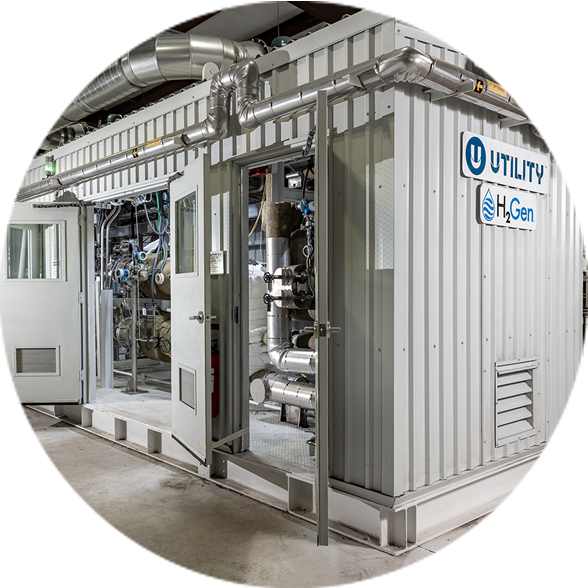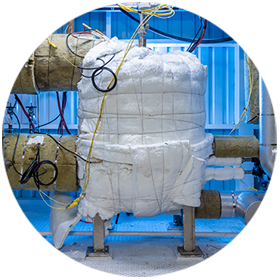Our Technology Platform
How eXERO® Works
The Electroless Coupled Exchange Reduction Oxidation technology platform, eXERO, capitalizes on both the advantages of electrochemical processes, which yield high product purity without the need for expensive purification steps, and chemical processes, which have comparatively low capital and operating costs, especially avoiding the losses of electricity generation and transmission.
The eXERO gas production technology is achieved by removing the external electrical circuit from an electrolyzer and instead driving the electrolysis reaction with the overpotential (voltage) that exists between different gas compositions. Similar to a conventional solid oxide electrolyzer, oxygen ions are transferred from the cathode to the anode through an oxygen ion-conducting electrolyte. However, unlike a conventional electrochemical reactor, electrons are transferred from the anode to the cathode through an electronically conducting phase within the electrolyte, also known as a mixed conducting electrolyte.


Principles
The eXERO gas production technology is based on two streams, which are separated by an impermeable electrolyte, and counter-exchange of oxygen ions and electrons. Thus, one of the streams undergoes reduction while the other stream simultaneously undergoes oxidation. Unlike traditional fuel cells or electrolyzers, no current is extracted or delivered to the reactor to drive the process. Rather, an overpotential can be induced by introducing gases of different composition at the anode and cathode of the cell. An example of gas introduced at the anode to induce an overpotential, relative to steam (water) is shown below.
A simple example is the introduction of pure carbon monoxide at the anode and pure steam at the cathode. The overall reaction occurring when carbon monoxide is used as the fuel is:
At the cell, the following reaction occurs:
CO + H2O -> H2 + CO2At the cathode, the following reaction occurs:
H2O + 2e- -> H2 + O2-
At the anode, the following reaction occurs:
CO + O2- -> CO2 + 2e-
The Nernst Equation can be used to calculate an overpotential generated across an electrolyte for varying gas atmospheres, as the electrical short circuit necessitates a cell potential difference of zero Volt. Therefore, with certain chemical compositions at the anode, steam in the cathode will spontaneously dissociate into hydrogen ions and oxygen ions. Using an oxygen ion-conducting electrolyte to separate the two streams, oxide ions can therefore be spontaneously driven across the electrolyte. As in a traditional solid oxide electrolyzer with an applied external overpotential, simultaneously, electrons flow from the anode to the cathode, forming hydrogen at the cathode.
When electricity production is not desired and hydrogen is the only product, the traditional stack required by standard fuel cells and electrolyzers is no longer required. A mixed conducting electrolyte is used to transport both electrons from the anode to the cathode and oxygen ions from the cathode to the anode in the eXERO gas production technology, enabling simpler and more robust architectures with the elimination of electrical continuity between cells.


